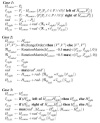Abstract
Traditional volume visualization techniques may provide incomplete clinical information needed for many applications in medical visualization. Especially in the area of vascular visualization important features such as the patent lumen of a diseased vessel segment may not be visible. Curved Planar Reformation (CPR) has proven to be an acceptable practical solution. Existing CPR techniques, however, still have diagnostically relevant limitations. In this paper we introduce two advanced methods for efficient vessel visualization, based on the concept of CPR. Both methods benefit from relaxation of spatial coherence in favor of improved feature perception. We present a new technique to visualize the interior of a vessel in a single image. A vessel is re-sampled along a spiral around the vessel central axis. The helical spiral depicts the vessel volume. Furthermore, a method to display an entire vascular tree without mutually occluding vessels is presented. Minimal rotations around the branching points of a vessel tree eliminate occlusions. For each viewing direction the entire vessel structure is visible.Keywords: computed tomography angiography, vessel analysis, curved planar reformation
Download full paper
Armin Kanitsar, Rainer Wegenkittl, Dominik Fleischmann, Meister Eduard Gröller, "Advanced Curved Planar Reformation: Flattening of Vascular Structures", submitted to IEEE Visualization 2003, AKanitsar_Adv.pdf (2.371KB).Figures in the paper
Additional Material
A short collection of animations related to this work: |
Animation 1:
A color coded sequence of untangled CPR images from different re-sampling directions (.avi) low resolution (mpg) (~0.000KB) high resolution (~9.111KB) |
 |
Animation 2:
Assembling of vessel hulls (.avi) low resolution (mpg) (~0.000KB) high resolution (~6.301KB) |
 |
Animation 3:
Untangled CPR with adaptive layout (.avi) low resolution (mpg) (~0.000KB) high resolution (~12.425KB) |
 |
Animation 4:
Untangled CPR with fixed layout (.avi) low resolution (mpg) (~0.000KB) high resolution (~12.518KB) |
BibTeX Entry
@INPROCEEDINGS{kanitsar:2003:Adv,
author = {Armin Kanitsar and Rainer Wegenkittl and Dominik
Fleischmann and Meister Eduard Gr\"oller},
title = {{A}dvanced {C}urved {P}lanar {R}eformation: {F}lattening of
{V}ascular {S}tructures},
booktitle = {{IEEE} {V}isualization 2003},
year = {2003},
month = oct,
pages = {43--50},
keywords = {computed tomography angiography, vessel analysis,
curved planar reformation},
institution = {Institute of Computer Graphics and Algorithms,
Vienna University of Technology},
url = {http://www.cg.tuwien.ac.at/research/vis/adapt/},
note = {human contact: technical-report@cg.tuwien.ac.at}
}















